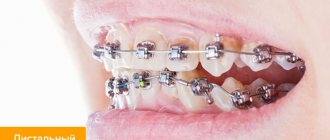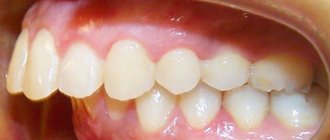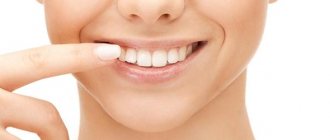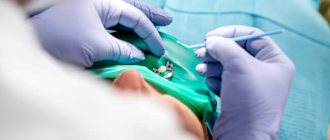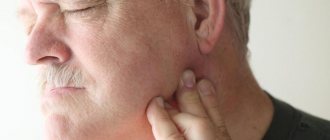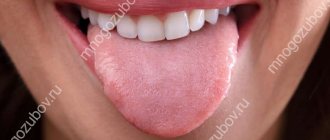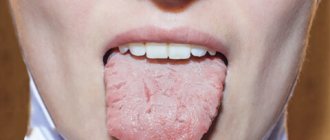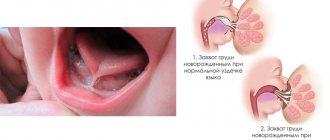Genetic predisposition, as well as some disorders of the growth and development of the maxillofacial apparatus, cause various defects of the dental system. Orthodontics deals with the treatment and prevention of dental anomalies. This dental industry uses various designs and devices to correct uneven teeth, eliminate malocclusions and other aesthetic and functional disorders.
In this article we will look at what onlays are in orthodontics.
, what problems they solve, their types, tooth movement, as well as
something new in orthodontics
- a bioactive adhesive for orthodontic structures.
Occlusal pads
In the treatment of various malocclusion defects, occlusal overlays are successfully used in orthodontics.
. They belong to the supporting-retaining elements and transmit functional forces to the supporting teeth from the side of the prosthesis bases. Installed on the lateral teeth.
Types of overlays by location:
- one-sided;
- double sided
The number and location of orthodontic structures is determined by the number of supporting teeth and their position in the dentition. Onlays are not installed on incisors and canines, as this can lead to displacement of the teeth.
And then... children's aligners appear on the scene!
With the advent of new digital technologies, the orthodontist discovered the world of transparent orthodontics - a painless, convenient method that allows you to set the correct vector for the development of the child’s dental system. Children's aligners are clear aligners that allow teeth to be moved in early childhood.
The first breakthrough in treating children without braces was made by Invisalign. Check out their advertising slogan below - it compares aligners with wireless communication ( Go wireless
), and in context - wireless technology, which we always associate with the braces system (there are also braces and the wire connecting them). The absence of wires and heavy braces on a child’s teeth eliminates many obstacles, inconveniences and removes restrictions on nutrition and hygiene:
The technology of treatment with aligners for children is to align baby (temporary) teeth and also promote the proper growth of permanent teeth. “Children’s aligner, mouthguard – what is it?”, you ask, what is the difference from a plate, what is better to choose? And why don’t all orthodontists offer this type of treatment?
The answer, dear friends, is obvious; this type of dentition correction is a breakthrough for 2021. If previously we had the opportunity to treat adults using aligners, now - hurray! and thank you very much! manufacturers - Invisalign, Star Smile, Flexilainer - for providing the opportunity to correct the bite in children with the help of aligners.
What do children's aligners do as opposed to plates?
Unlike dental plates, bite alignment with aligners in children allows teeth to move in all planes in the same way as with aligners for permanent dentition in adults.
The initially specified correct vector of tooth movement in the aligner treatment technology makes it possible to straighten both the child’s already erupted teeth and those just beginning to erupt.
Thus, aligners for children contribute to the proper growth of permanent teeth.
Early treatment
. Treatment with aligners can begin from the age of 5 while still in the primary dentition. At this age, malocclusion in children is corrected quickly.
Aligners do not damage the enamel, and there are no dietary restrictions when wearing them. On the contrary, it is recommended to eat hard, wholesome foods (among them carrots, apples, cucumbers) in order to train the chewing muscles.
The treatment goes unnoticed by others, the child feels comfortable, they are easily removed and are not noticeable in the mouth
.
He won't be teased
, since the aligners are invisible when you talk or smile.
Alignment aligners are safer
, they are smooth, fit tightly to the teeth, the tongue does not catch on the children's aligner, and speech defects are less pronounced than with other orthodontic systems.
With children's aligners, there is no need to worry about food getting stuck in the aligner.
or hard parts of food will damage the aligners.
The child can brush his teeth and eat as usual: removable aligners do not interfere with hygiene
.
It is much easier for a child to care for aligners than for braces - no special brushes
. For care, simply rinse the aligners with warm water and a special solution or simply brush with a regular toothbrush.
Control of tooth movement on children's aligners
Using a special computer program, the doctor demonstrates the results of orthodontic treatment BEFORE it begins. In 3D format, the child and his parents will see how and in what time frame the teeth will move (a colorful cartoon).
All manufacturers have their own computer programs for 3D visualization of the final result of bite correction in children: Invisalign has the CleanCheck
, Star Smile has a virtual 3D setup, FlexiLigner has the OrthoCheck program.
At each stage of treatment there is a unique opportunity to carry out additional correction according to clinical need, for example: loss of a baby tooth, or premature eruption outside the dentition.
Visit to the doctor
. With early correction of primary occlusion using aligners, visits to the orthodontist are not frequent, once every 1.5-2 months is sufficient. A repeated visit to the doctor does not take much time; basically, the doctor gives the patient sets of aligners and takes photographs during the treatment phase. The appointment takes no more than 15-20 minutes.
Children need to wear aligners constantly, day and night, and remove them only when eating or brushing their teeth. Which is very simple, convenient and very comfortable even for the smallest children.
What problems do orthodontic onlays solve?
Occlusal pads reduce the immersion of the prosthesis into the mucosa, thereby preventing compression of the gingival margin of the corresponding supporting teeth.
Other functions of the overlays:
- obstruction of prosthesis settlement;
- unloading the abutment tooth from lateral loads;
- transfer of chewing load from the prosthesis to the supporting teeth.
They also ensure a stable position of the denture on the jaw and prevent the penetration of food into the space between the base and supporting teeth.
Crowns
With the help of crowns, chewing and frontal teeth are restored when they are so damaged that installing a filling is no longer possible. Crowns differ in the type of material they are made from.
Metal-ceramic crowns
They have a frame made of precious metals or nickel, cobalt-chrome. The top of the frame is covered with several layers of ceramic composition. Such crowns are quite reliable, however, they are not entirely aesthetic. Due to the metal frame, the tooth may look darker. In addition, an allergic reaction to the metal may occur.
Metal-plastic crowns
In this case, the metal frame is covered with a plastic mass. This significantly reduces the cost of the design and makes it lightweight. It is worth keeping in mind that the service life of a plastic product is not long. In addition, the coating is susceptible to staining and has low strength. Metal-plastic is used as a temporary solution to the problem.
Metal-free crowns
A fairly durable, reliable, aesthetic way to restore teeth. Most often they are used for the frontal region, as they have a similar transparency to their teeth. They are hypoallergenic and have ideal compatibility with soft tissues.
Zirconium dioxide crowns
The most durable and cost-effective method of dental prosthetics. Crowns are made from zirconium dioxide and a layer of ceramic is applied to the base. Used to restore all types of teeth.
Front overlays
In orthodontic treatment, frontal overlays are also used, divided into two groups: single and multi-unit.
Types of single front overlays:
- oral – installed on the distal surface of the tooth;
- medial – used when there is slight mobility of the supporting canines;
- shoulder pads – stabilize the prosthesis, used for splinting mobile teeth;
- double-arm rest - used when defects are included in order to replace clasps, installed on the distal side of the fangs.
Multi-link linings come in narrow, medium and widened types. They provide support and stabilization of the prosthesis, but do not fix it. They are used for Kennedy dentition defects on the lower front teeth.
Tabs
An inlay is an insertion into the cavity of a chewing tooth in order to restore its chewing function. It is made individually and fixed with medical cement. In fact, it replaces a filling and surpasses it in reliability and durability.
Tooth restoration with onlays (or inlays) is used in the following cases:
- tooth destruction by 20-50%
; - the presence of defects that are not comparable to the installation of the filling;
- exposure of enamel to increased abrasion;
- need to replace the old filling.
The inlays also differ in the type of material made and are:
- Metal
. Made from precious and medical metals. They are not aesthetically pleasing and can cause allergies. However, they are affordable. - Ceramic
. This is the most reliable material that perfectly restores the damaged surface. In addition, such an onlay will be absolutely indistinguishable from the original tooth. The ceramic onlay on the tooth is not stained and completely restores functionality and aesthetics.
Moving teeth in orthodontics
When treating various defects of the dental system, the method of moving individual teeth or a group is often used. For this purpose, special springs are used, divided into several groups.
Types of orthodontic springs:
1. Serpentine - vestibular teeth move body-wise or around an axis.
2. Finger-shaped - used for corpus vestibular movement.
3. Hand-shaped - provide effective mesio-distal movement of individual teeth, mainly frontal ones.
4. With a round crossed curl - used for mesio-distal movement.
5. Oval spring in orthodontics
designed to move a group of cutters.
Purpose, characteristics and types of orthodevices
Structurally, it is a removable device with which you can align a row and correct a number of defects associated with the incorrect position of individual units, curvatures, and the presence of cracks. The installation of plates allows, during the period of active development of the jaw, to direct the growth of teeth and move them to the anatomical position that they should occupy.
Indications for installing an orthodontic plate for children:
- incorrect position, there are large gaps or there is no space for cutting through individual units;
- narrowing the row;
- baby teeth were removed early, which caused developmental disorders;
- the lower and upper jaws do not correspond in size, there are positional defects;
- asymmetry of facial contours.
Orthodontic plates for teeth used for treatment are divided according to design, type, purpose, and materials of manufacture. These parameters distinguish:
- Single-jaw products have a plastic base and adjustment screws that allow you to adjust the pressure. This is a removable model with a mechanical action, recommended for use with temporary and permanent dentition, shortening of the row, and growth anomalies. The design feature allows you to quickly move individual groups or individual teeth, returning them to their correct anatomical position.
- With retraction arches – this is a product with a plate-type base and a vestibular arch. The device is mechanical, removable, recommended for protrusion. For correction, a special wire spring is used, which allows you to quickly move the units of the anterior group.
- With arm-shaped processes - a mechanical action apparatus. Correction is carried out by applying pressure to the tooth in the neck area.
- With pushers - this type of design has one or more springs, the base is made of durable plastic. Used for vestibular movement, primary or permanent dentition.
- The Andresen-Goipl activator is designed as a monoblock. It is designed to restore normal position in various pathologies.
- The Brückle apparatus is used for vestibular movement, normalization of muscle function in a certain area, and correction of crooked upper front teeth.
- The Frenkel function apparatus in the form of two shields with a metal base is used at any age. The design is effective for deep, open or mesial bites.
New bioactive adhesive in orthodontics
Orthodontic treatment uses the latest technologies to eliminate various defects of the dentofacial apparatus, including in complex cases. But scientists do not stop at these achievements; they continue their research activities and develop new materials that facilitate the process of orthodontic treatment, reducing correction time and eliminating various negative consequences.
Latest news in orthodontics
will undoubtedly delight patients who are undergoing treatment with braces. These structures successfully cope with various malocclusion defects, but, as analysis shows, 70% of people develop caries on the surface of their teeth after wearing braces. This is due to the accumulation of plaque under the structure, which is difficult to clean out during hygienic cleaning.
Researchers from London offer a successful solution to this problem. They have created a new bioactive adhesive that has a remineralization effect on the surface of teeth, which significantly reduces the risk of developing caries. The unique material will increase the effectiveness of hygienic care of teeth and gums when wearing braces.
According to the developers, the new adhesive should be available for sale in the next couple of years.
Composition and main varieties
Temporary veneers to protect tooth enamel can be made from a variety of materials and come in different types. Artificial dentin is made from a special composite diluted with water in a certain proportion. This mass can harden in 2-3 hours. Dentin paste is a composite combined with antiseptic additives.
Cement is also often used; it is considered one of the strongest and most durable materials. It is especially popular when identifying a patient with a pathology such as bruxism (teeth grinding during sleep and during severe stress). The orthodontist can also use polymer materials that resemble rubber mass in their appearance and properties.
While wearing the veneers, the patient is advised to adhere to some simple rules regarding oral hygiene and diet. First of all, you should avoid foods that are too hard and chewy, such as nuts, toffees and chewing gum. You will also have to exclude very hot or very cold foods from your menu, such as ice cream. This will not only extend the life of the onlays, but will also preserve the health of your teeth.
previous post
Braces after 40
next entry
Modern orthodontic treatment at the Moscow Dental Center
Professional orthodontic treatment of the dentofacial apparatus is carried out by experienced specialists. The latest technologies, modern equipment and high-quality materials are used in diagnostic and treatment procedures. Our center employs pediatric and adult orthodontists. You can make an appointment for a free consultation by phone.
We have affordable prices for all types of dental and orthodontic procedures. Regular clients are provided with discounts on dental services. All patients who leave reviews on the site receive an additional discount of 3% (the discount is added to the client’s main discount).
Advantages and disadvantages
The advantages of using orthodontic structures in the form of plates for correction include:
- relatively light weight, causing discomfort during treatment;
- high efficiency rates thanks to a wide selection of devices;
- the ability to correct various types of defects;
- effectiveness for children aged 10-12 years;
- the possibility of starting treatment at any age, including the period of development of the jaw apparatus;
- affordable cost of plates in comparison with classic braces.
There are no downsides, the only inconvenience is the need to regularly visit a doctor to monitor recovery. You must strictly follow all the recommendations and not violate the orthodontist’s appointment schedule.
Rules of care and cost
In order to maintain oral health, the Patient is required to take the following measures:
- daily brushing, using dental floss and irrigator to remove food debris and plaque accumulations;
- using mouthwash before bed and after every meal;
- control visits to the doctor for prevention and timely treatment;
- office cleaning every six months, using products to strengthen the enamel.
Parents must ensure that all requirements are met, including brushing at least twice a day. To do this, you need to purchase special brushes, after consulting with our hygienist. He will select the optimal means with which you can independently observe the necessary hygiene measures at home.
The cost of treatment depends on the type of structure used. You can buy the following types of orthodontic plate from us:
- removable devices – from 12.4 thousand depending on the type, purpose, number of units;
- LM activators – 14 thousand and more.
In comparison, the cost of standard design options:
- classic metal brace systems – from 200 thousand rubles;
- lingual models - approximately 250 thousand for one jaw;
Exact prices are announced after choosing the type of orthodontic device, diagnostics and other measures. Therefore, it is recommended to first visit a doctor and undergo an examination to obtain the necessary data.
About Us
The Magenta Dental clinic offers painless and effective orthodontic treatment for children. We guarantee long-term results and a high level of quality. Advantages of contacting us:
- highly qualified specialists with experience working with children;
- modern materials and technologies certified for use in Europe and Russia;
- 15 years of experience and more than 1000 satisfied Patients;
- comfortable conditions for everyone;
- reasonable cost and guaranteed results.
To register, leave a request by phone. We work seven days a week; you can consult with the clinic’s doctors any day from 9:00 to 21:00. You can submit a request using the form on the website or send it by email
